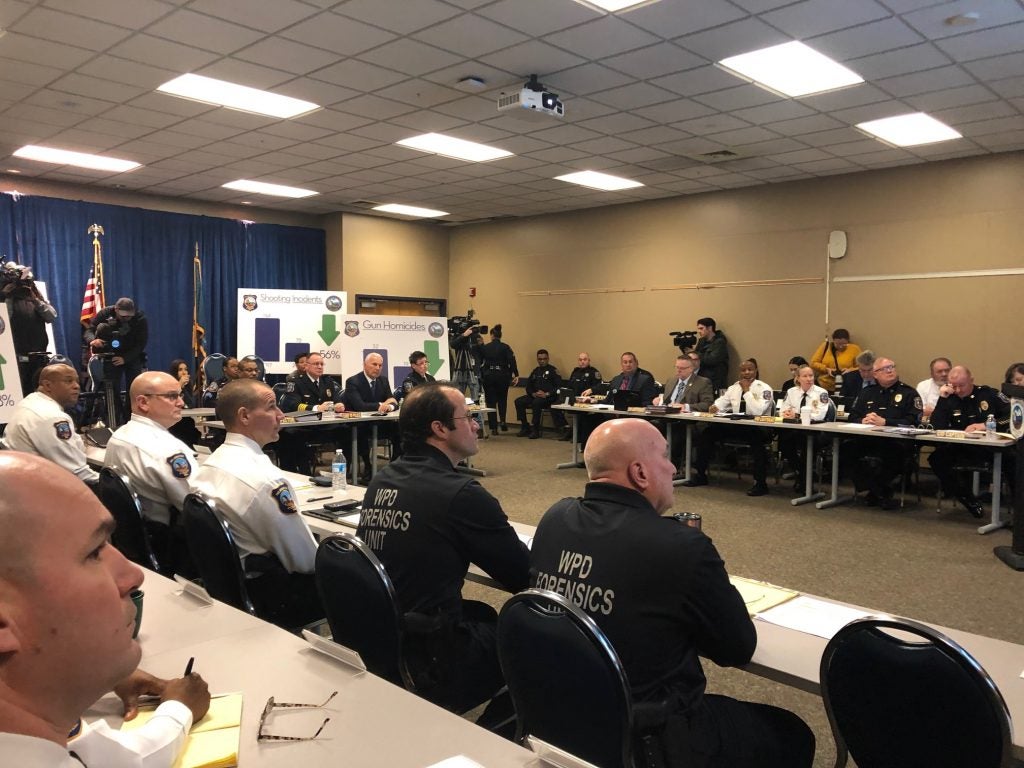Wilmington shooting, homicide rates plummet
The number of shooting victims fell 60 percent from 2017 to 2018 in Wilmington. The police chief cites use of real-time crime data and better relations with residents.

Wilmington police chief Robert Tracy (left) and Mayor Mike Purzycki held a news conference to talk about what the mayor called "remarkable progress'' in reducing gun violence in 2018. (Cris Barrish/WHYY)
During 2017, Wilmington Mayor Mike Purzycki’s first year in office, one of his primary goals was reducing gun violence.
But during his first four days in office, three people were shot to death. The carnage continued. Instead of safer streets, blood flowed from a record 194 shooting victims, including 32 who died.
But on Thursday, midway into his four-year term, Purzycki and his handpicked police chief had some far better news to report for 2018.
Purzycki and Chief Robert Tracy stood before a handful of charts at a news conference to showcase that 79 people were shot last year, a 60 percent drop from 2017 and the lowest number in 17 years. Homicides also fell substantially, and more of them were solved even as citizen complaints of excessive force and other misbehavior by officers fell.
Purzycki wasn’t declaring victory. But he was pleased with the fact that city streets are safer, calling the reductions “remarkable progress.”
“What I want us all to remember is that for every reduced shooting victim, one less family endured the agony of personal loss,’’ the mayor said. “Every prevented act of violence represents one less traumatic experienced that neighborhood children will have to endure. Every reduction is one less nerve-rattling experience that our neighbors fear for their own safety.”
Tracy came to Wilmington in April 2017 after leadership stints in Chicago and New York. He credits computerized crime analytics for improving how police are deployed. He stressed that officers aren’t judged by the number of arrests but rather by how much crime drops in their designated sectors.
He wants his cops to build bonds with residents, not lock them up.
“It’s community cooperation and trust that starts to show those numbers,’’ he said.
When officers “show up at a shooting or a murder, that’s not the first time we had a conversation with the community,” he said. “We’ve had it, established it and they know us and they are going to give us information because they don’t want that in their community either.”

Tracy also credited weekly meetings of his force’s team known as CompStat, short for “comparison statistics.”
At the meetings, some three dozen city police leaders from various units, along with representatives of the U.S. attorney’s office, Delaware attorney general’s Office and the Bureau of Alcohol Tobacco, Firearms and Explosives meet to review statistics from the city. The data is calculated among three sectors that are divided into 19 police districts.
The mayor and chief said they realize much more still needs to be done. For example, the stats show that aggravated assaults are up, a rise the chief blamed on domestic violence cases.
Purzycki stressed that for the city to become even safer in coming years, life in the poorest neighborhoods needs to improve, especially for impressionable children.
“The big public policy question is what we do to create a nurturing environment for our kids to grow up in,’’ he said.
“Our kids grow up in terrible, terrible conditions in some places. We have tried to change the game on being able to get our landlords to really up their games so that these kids live in a much, much more positive environment.”
In recent years, many have called the city Murder Town. But the mayor wants Wilmington to have a new moniker: Turnaround Town.
WHYY is your source for fact-based, in-depth journalism and information. As a nonprofit organization, we rely on financial support from readers like you. Please give today.





